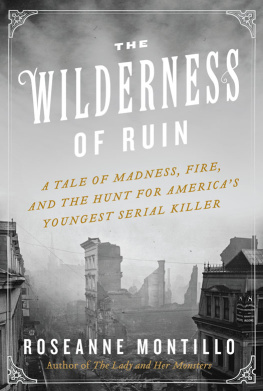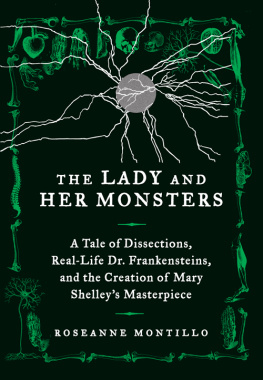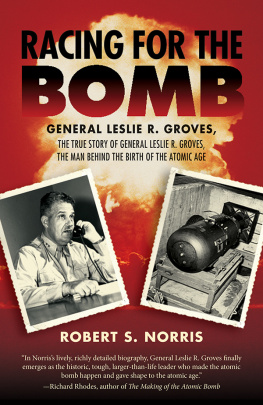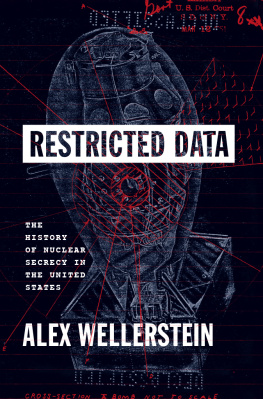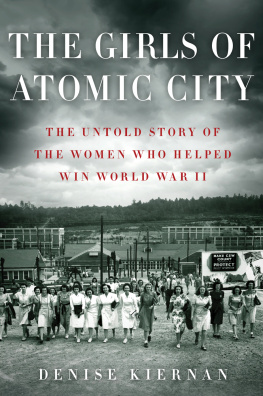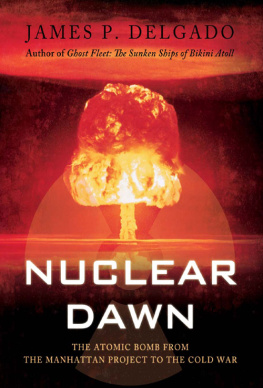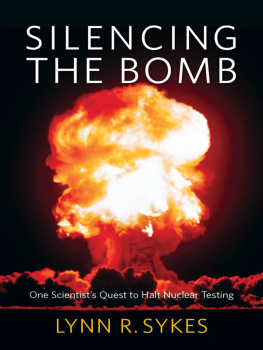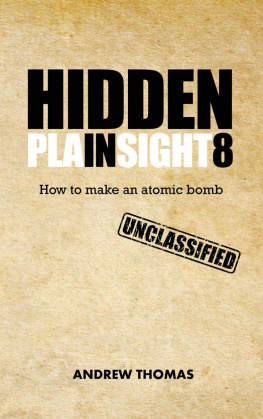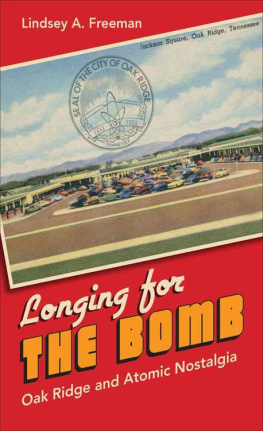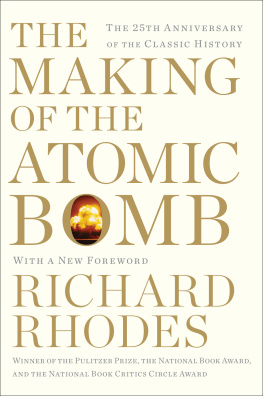Roseanne Montillo - Atomic Women: The Untold Stories of the Scientists Who Helped Create the Nuclear Bomb
Here you can read online Roseanne Montillo - Atomic Women: The Untold Stories of the Scientists Who Helped Create the Nuclear Bomb full text of the book (entire story) in english for free. Download pdf and epub, get meaning, cover and reviews about this ebook. year: 2019, publisher: Little, Brown Books for Young Readers, genre: Non-fiction. Description of the work, (preface) as well as reviews are available. Best literature library LitArk.com created for fans of good reading and offers a wide selection of genres:
Romance novel
Science fiction
Adventure
Detective
Science
History
Home and family
Prose
Art
Politics
Computer
Non-fiction
Religion
Business
Children
Humor
Choose a favorite category and find really read worthwhile books. Enjoy immersion in the world of imagination, feel the emotions of the characters or learn something new for yourself, make an fascinating discovery.

- Book:Atomic Women: The Untold Stories of the Scientists Who Helped Create the Nuclear Bomb
- Author:
- Publisher:Little, Brown Books for Young Readers
- Genre:
- Year:2019
- Rating:3 / 5
- Favourites:Add to favourites
- Your mark:
- 60
- 1
- 2
- 3
- 4
- 5
Atomic Women: The Untold Stories of the Scientists Who Helped Create the Nuclear Bomb: summary, description and annotation
We offer to read an annotation, description, summary or preface (depends on what the author of the book "Atomic Women: The Untold Stories of the Scientists Who Helped Create the Nuclear Bomb" wrote himself). If you haven't found the necessary information about the book — write in the comments, we will try to find it.
Roseanne Montillo: author's other books
Who wrote Atomic Women: The Untold Stories of the Scientists Who Helped Create the Nuclear Bomb? Find out the surname, the name of the author of the book and a list of all author's works by series.
Atomic Women: The Untold Stories of the Scientists Who Helped Create the Nuclear Bomb — read online for free the complete book (whole text) full work
Below is the text of the book, divided by pages. System saving the place of the last page read, allows you to conveniently read the book "Atomic Women: The Untold Stories of the Scientists Who Helped Create the Nuclear Bomb" online for free, without having to search again every time where you left off. Put a bookmark, and you can go to the page where you finished reading at any time.
Font size:
Interval:
Bookmark:
Copyright 2020 by Roseanne Montillo
Cover art copyright 2020 by Neil Swaab
Cover design by Karina Granda
Cover copyright 2020 by Hachette Book Group, Inc.
Hachette Book Group supports the right to free expression and the value of copyright. The purpose of copyright is to encourage writers and artists to produce the creative works that enrich our culture.
The scanning, uploading, and distribution of this book without permission is a theft of the authors intellectual property. If you would like permission to use material from the book (other than for review purposes), please contact permissions@hbgusa.com. Thank you for your support of the authors rights.
Little, Brown and Company
Hachette Book Group
1290 Avenue of the Americas, New York, NY 10104
Visit us at LBYR.com
First Edition: May 2020
Little, Brown and Company is a division of Hachette Book Group, Inc.
The Little, Brown name and logo are trademarks of Hachette Book Group, Inc.
The publisher is not responsible for websites (or their content) that are not owned by the publisher.
Photographs courtesy of the Los Alamos Historical Society.
Library of Congress Cataloging-in-Publication Data
Names: Montillo, Roseanne, author.
Title: Atomic women : the untold stories of the scientists who helped create the nuclear bomb / Roseanne Montillo.
Description: New York : Little, Brown and Company, [2020] | Includes bibliographical references and index.
Identifiers: LCCN 2018050922| ISBN 9780316489591 (hardcover) | ISBN 9780316489584 (ebook) | ISBN 9780316489614 (library edition ebook)
Subjects: LCSH: Women physicistsUnited StatesBiography. | Nuclear engineersUnited StatesBiography. | Nuclear physicsResearchUnited StatesHistory20th century. | Nuclear weaponsUnited StatesHistory20th century.
Classification: LCC QC15 .M56 2019 | DDC 355.8/2511909252dc23
LC record available at https://lccn.loc.gov/2018050922
ISBNs: 978-0-316-48959-1 (hardcover), 978-0-316-48958-4 (ebook)
E3-20200324-JV-NF-ORI

To the unsung female scientists throughout the ages
July 15, 1945, New Mexico
I n a cabin on the grounds of Harry Millers Tourist Court, in the town of Carrizozo, Elizabeth Diz Graves and her husband, Al Graves, were busy setting up their equipment. Intertwining wires of various colors crisscrossed the room, and odd contraptions with several buttons to press sat atop window sills, along with timers ready to buzz, all to monitor the level of radiation that was about to drift in from the test area. The Gadget, as the test bomb was originally known, had been brought to an isolated desert spot in New Mexico known as Jornada del Muerto, Spanish for Journey of the Dead Man, a name many people would eventually find very appropriate. The secret mission, and the Gadget itself, had been code-named Trinity, referencing a poem by the famous English poet John Donne.
Diz and Al Graves had also lugged to the cabin a seismograph (an instrument to measure the grounds vibrations), a Geiger counter (a type of particle detector to measure emissions during a nuclear blast), a shortwave radio (a type of long-range radio transmission that allowed Diz and Al to hear signals from a distance), and a portable electric generator. The man whod rented them the cabin had found it all very strange, this young couple dragging along so much unusual equipment, and asked out loud if they planned to blow up the area. Diz and Al hadnt answered him but merely smileda private joke passing between them, one the man would never understand. They went on to tell the owner that they would stay just two nights, as they were driving across the country and were only stopping for a short rest. The owner must have thought it odd that a heavily pregnant woman would be driving so many miles in the heat, for any reason at all. But he didnt say anything and he didnt require any further explanations.
On entering the cabin, Al had spread their gear on the floor and atop one side of the bed, leaving a portion of it empty in case Diz needed or wanted to lie down, although he didnt think she would take advantage of a rest.
Diz was now a little over seven months pregnant and, suddenly worried that the radiation would hurt the unborn child, had asked her superiors for an assignment some distance away from the test site. Compared with the experiments shed undertaken before, this project was the most dangerous of them all.
Her husband had supported her decision, although he had been surprised by her request to be away from the main site. When hed met her during his graduate studies, such a thing as a little radiation would not have bothered her. Her fearlessness and drive were the two character traits that had appealed to him more than anything else about her personality. She had also possessed a bit of a gruff exterior that dared anyone to tell her how things ought to be done or to disagree with her. Thats why he found it odd to see her so skittish, so concerned about the outcome of the experiment, though he knew it was because of the baby.
As he unpacked his equipment in the cabin, Al watched his wife walk up and down the room, either worried about the blast or because the baby was moving wildly inside her. Diz was excited, and while she knew that she was still some weeks away from delivery, she hoped the pressure she felt wouldnt induce contractions.
The cabin in Harry Millers Tourist Court had a window facing west toward the test site, and on its sill Al had propped the Geiger counter. They checked all the instruments, and as darkness cloaked the area they began to listen over the shortwave to the voices coming from the test area. Hours later, they heard the countdown, and they began to whisper along with it as it inched forward. During the last seconds, the shortwave radio failed, and the voice faded away. Diz continued to count on her own, keeping track.
Although the test site was nearly thirty miles away, they heard the blast clearly, and Diz Graves knew that the bomb had gone off. All her worries and questions would now be answered. The radioactive fallout brought along by the wind did not reach them until some hours later, and by the afternoon, Diz was alarmed to see the readings on the Geiger counter as its needle swung to the right. As more hours passed, the needle on the counter shot all the way off the scale. Al shared his wifes concerns and he decided to telephone base camp to see what the scientists were doing. He was informed that General Leslie Groves and various members of the military were trying to figure out whether or not the areas residents needed to be evacuated, but while Al was on the phone, he learned that they had decided against evacuation. Diz continued to take readings, her mind eased by the fact that by late evening the radiation levels had tapered off. Al made a quick telephone call to the officials to let them know the latest developments.
Despite their eagerness to complete the project, Al and Diz Graves, like many in the scientific community, had come to suspect that they were leaning over the edge of the unknown and were afraid of what they would discover there. While the bomb was being constructed, they had wondered what truly would happen if and when it exploded. Would it actually work? What would the outcome be if it did?
They had joined the others in Los Alamos because they feared that the Second World War would last for several more years, that Adolf Hitler would be the first to build the bomb and unleash it on the rest of the world, and that every other country would have to pay the consequences. They had, in a sense, asked no questions about the validity of their work; they had not wondered about the lives of the innocents who would be caught in the middle of the conflict or whether they should have built the bomb just because they had the means to. It had seemed to them that what they were doing was justified, the only course of action they could have taken to save their lives and the lives of others.
Font size:
Interval:
Bookmark:
Similar books «Atomic Women: The Untold Stories of the Scientists Who Helped Create the Nuclear Bomb»
Look at similar books to Atomic Women: The Untold Stories of the Scientists Who Helped Create the Nuclear Bomb. We have selected literature similar in name and meaning in the hope of providing readers with more options to find new, interesting, not yet read works.
Discussion, reviews of the book Atomic Women: The Untold Stories of the Scientists Who Helped Create the Nuclear Bomb and just readers' own opinions. Leave your comments, write what you think about the work, its meaning or the main characters. Specify what exactly you liked and what you didn't like, and why you think so.

